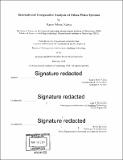International comparative analysis of urban water systems
Author(s)
Noiva, Karen Marie
DownloadFull printable version (38.82Mb)
Other Contributors
Massachusetts Institute of Technology. Department of Architecture.
Advisor
John E. Ferndndez.
Terms of use
Metadata
Show full item recordAbstract
This dissertation presents a new approach to structuring global diversity for a large number of urban water systems, so that trends observed in a small number of cases can contribute to a more general understanding of the spectrum of contemporary sustainability challenges faced by cities around the world. The two-part approach first uses a large number of cities (large-n, i.e. n = 142) to identify a typology which is used to guide the choice of two cases (small-n, i.e. n = 2) for further analysis. In the first part of the approach, I compare a large number (large-n) of urban water systems. Simple profiles of key attributes of urban water supply and demand-population (N), water use intensity (WN), and net annual water balance data (qNet)-are assembled from common global databases. Univariate and bivariate methods are used to identify global trends. I introduce two new indicators that benchmark urban water use intensity against climatic availability: the Water Use and Climate Index (WUCI, with units of m²) and the Potential Self-Sufficiency Ratio (Rss, unitless) and find that 65% of cities in the study have Rss >/= 1. I then use exploratory statistical clustering algorithms to identify six type of urban water systems profiles, ranging from small, wet cities with low WUCI and high Rss to large cities with high water use intensity, high WUCI, and lower Rss. In the second part of the approach, I demonstrate the use of that typology in framing case study choice for small-n international comparative analysis of urban water systems. I choose Los Angeles and Singapore from Type 4, which have large populations and high water use intensity but different climates. I apply univariate and bivariate methods to identify trends over time in water system profiles of LA and Singapore. Calculating WUCI and the Potential Self-Sufficiency Ratio for the two cases provides insight into historical behavior and future targets. Finally, I use these results to construct simple simulations to assess past behavior and future targets.
Description
Thesis: Ph. D., Massachusetts Institute of Technology, Department of Architecture, 2018. Cataloged from PDF version of thesis. Includes bibliographical references (pages 223-251).
Date issued
2018Department
Massachusetts Institute of Technology. Department of ArchitecturePublisher
Massachusetts Institute of Technology
Keywords
Architecture.